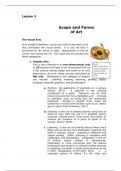Lesson 3
Scope and Forms
of Art
The Visual Arts
In its simplest definition, visual arts refer to any work of art
that stimulates the visual sense. It is any art that is
perceived by the sense of sight. Appreciation of the art
comes from seeing the art. The visual arts are divided into
these categories:
1. Graphic Arts.
This is also referred to as two-dimensional arts Source:
https://www.123rf.co
or 2D because this type of art is executed only on m/photo_8302824_ill
a flat surface having length and width as its only ustration-of-color-
dimensions. As such, these are also described as plate-with-brush-on-
white-
flat arts. Belonging to the category of graphic background.html
arts include: painting, drawing, lettering, printing, digital
imaging, computer graphics, and photography.
a. Painting the application of pigments on a surface
(Evans, 2017). A pigment is the coloring
component of a paint. Pigments can be from
natural sources like from vegetables and minerals
or synthetic such as those that are chemically
produced. Usually in powder form, these are
combined or mixed with binders such as oil, water,
gum or glue (Free Dictionary, 2017).
b. Drawing is the art of creating figures using lines or
areas of tone with the use of a graphite pencil,
charcoal, colored pencil, silver point, dry pastel, or
another dry medium on a piece of paper or on
canvas (Evans, 2019).
c. Lettering is the art of drawing letters where each
letter acts as its own mini illustration; meaning, the
letter is actually drawn. Lettering is different with
simple writing. Often, lettering is mistaken with
calligraphy and typography. Calligraphy is the art
of writing letters related to penmanship.
Calligraphy is more concerned with the special
techniques and strokes in writing the letter whereas
in lettering, the letter is drawn and becomes an art
in itself. Typography, on the other hand, is a
repeated system of letters. It’s the style and
, appearance of a printed material or the art of
arranging type. It’s not a specific style of writing or
creating letters and words, but more the
arrangement of how those letters appear together
in a system. In a nutshell, “Lettering is the art of
drawing letters; Calligraphy is the art of writing
letters; Typography is the art of using letters”
(“Hand-Lettering, Calligraphy, Typography: What’s
the Difference”, 2017).
d. Printing is a graphic art where prints are produced
by drawing or carving an image onto a hard surface
(known as a matrix) such as a wood block, metal
plate, or stone. This surface is then inked and the
image is transferred to paper or another material
by the application of pressure, thus creating an
impression or print. The printed image that results
is the exact reverse of the image on the plate
(“What is Print?”, 2021).
e. Digital Imaging is the production of an image with
the use of computers. Whether you take a picture
with a digital camera or use a scanner to bring a
photo (or other artwork) into Photoshop, you
are digitizing the image. That is, digit not as in a
finger or toe, but as in a number. Computers do
everything — absolutely everything — by
processing numbers, and the basic language of
computers is binary code. In a nutshell, binary code
uses a series of zeros and ones (that’s where the
numbers part comes into play) to record
information. So, what does binary code have to do
with photos? An image in Photoshop consists of tiny
squares of color called pixels (pixel is short
for picture element), as you can see in the close-up
to the right in the figure. The computer records and
processes each pixel in binary code. These pixels
replicate a photo the same way that tiles in a
mosaic reproduce a painting (Bauer, 2018).
f. Computer Graphics is a graphic art where pictures
are drawn on a computer screen. When you draw a
picture on the computer screen, what you have is a
digital information. Inside the computer, the
picture is stored as a series of numbers. Change
the numbers and you can change the picture in the
blink of an eye. It’s easy to shift your picture
around the screen, scale it up or down, rotate it,
swap the colors, and transform it in all kinds of
other ways. Once it is finished, you can save it,
incorporate it into a text document, print it out,
upload it to a web page, or even email it to a
recipient- all this can be done because it image
produced is a digital information (Woodford, 2021).




